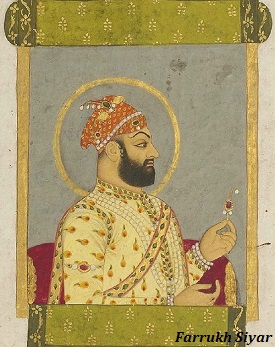
- Modern Indian History - Home
- Decline of Mughal Empire
- Bahadur Shah I
- Jahandar Shah
- Farrukh Siyar
- Muhammad Shah
- Nadir Shah’s Outbreak
- Ahmed Shah Abdali
- Causes of Decline of Mughal Empire
- South Indian States in 18th Century
- North Indian States in 18th Century
- Maratha Power
- Economic Conditions in 18th Century
- Social Conditions in 18th Century
- Status of Women
- Arts and Paintings
- Social Life
- The Beginnings of European Trade
- The Portuguese
- The Dutch
- The English
- East India Company (1600-1744)
- Internal Organization of Company
- Anglo-French Struggle in South India
- The British Conquest of India
- Mysore Conquest
- Lord Wellesley (1798-1805)
- Lord Hastings
- Consolidation of British Power
- Lord Dalhousie (1848-1856)
- British Administrative Policy
- British Economic Policies
- Transport and Communication
- Land Revenue Policy
- Administrative Structure
- Judicial Organization
- Social and cultural Policy
- Social and Cultural Awakening
- The Revolt of 1857
- Major Causes of 1857 Revolt
- Diffusion of 1857 Revolt
- Centers of 1857 Revolt
- Outcome of 1857 Revolt
- Criticism of 1857 Revolt
- Administrative Changes After 1858
- Provincial Administration
- Local Bodies
- Change in Army
- Public Service
- Relations with Princely States
- Administrative Policies
- Extreme Backward Social Services
- India & Her Neighbors
- Relation with Nepal
- Relation with Burma
- Relation with Afghanistan
- Relation with Tibet
- Relation with Sikkim
- Relation with Bhutan
- Economic Impact of British Rule
- Nationalist Movement (1858-1905)
- Predecessors of INC
- Indian National Congress
- INC & Reforms
- Religious & Social Reforms
- Religious Reformers
- Women’s Emancipation
- Struggle Against Caste
- Nationalist Movement (1905-1918)
- Partition of Bengal
- Indian National Congress (1905-1914)
- Muslim & Growth Communalism
- Home Rule Leagues
- Struggle for Swaraj
- Gandhi Assumes Leadership
- Jallianwalla Bagh Massacre
- Khilafat & Non-Cooperation
- Second Non-Cooperation Movement
- Civil Disobedience Movement II
- Government of India Act (1935)
- Growth of Socialist Ideas
- National Movement World War II
- Post-War Struggle
- Clement Attlee’s Declaration
- Reference & Disclaimer
Modern Indian History - Farrukh Siyar
Jahandar Shah's inglorious reign came to an early end in January 1713 when he was defeated at Agra by his nephew Farrukh Siyar.
Farrukh Siyar owed his victory to the Sayyid brothers, Abdullah Khan and Husain Ali Khan Baraha, who were therefore given the offices of wazir and nur bakshi respectively

The Sayyid brothers soon acquired dominant control over the affairs of the state and Farrukh Siyar lacked the capacity to rule. He was coward, cruel, undependable, and faithless. Moreover, he allowed himself to be influenced by worthless favorites and flatterers.
In spite of his weaknesses, Farrukh Siyar was not willing to give the Sayyid brothers a free hand but wanted to exercise personal authority.
The Sayyid brothers were convinced that administration could be carried on properly, the decay of the Empire checked, and their own position safeguarded only if they wielded real authority and the Emperor merely reigned without ruling.
There was a prolonged struggle for power between the Emperor Farrukh Siyar and his wazir and mir bakshi.
Year after year the ungrateful Emperor intrigued to overthrow the two brothers, but he failed repeatedly. In the end of 1719, the Sayyid brothers deposed Farrukh Siyar and killed him.
In Farrukh Siyar place, they raised to the throne in quick succession two young princes' namely Rafi-ul Darjat and Rafi ud-Daulah (cousins of Farrukh Siyar), but they died soon. The Sayyid brothers now made Muhammad Shah the Emperor of India.
The three successors of Farrukh Siyar were mere puppets in the hands of the Saiyids Even their personal liberty to meet people and to move around was restricted. Thus, from 1713 until 1720, when they were overthrown, the Sayyid brothers wielded the administrative power of the state.
The Sayyid brothers made a rigorous effort to control rebellions and to save the Empire from administrative disintegration. They failed in these tasks mainly because they were faced with constant political rivalry, quarrels, and conspiracies at the court.
The everlasting friction in the ruling circles disorganized and even paralyzed administration at all levels and spread lawlessness and disorder everywhere.
The financial position of the state deteriorated rapidly as zamindars and rebellious elements refused to pay land revenue, officials misappropriated state revenues, and central income declined because of the spread of revenue farming.
The salaries of officials and soldiers could not be paid regularly and soldiers became undisciplined and even mutinous.
Many nobles were jealous of the 'growing power of the Sayyid brothers. The deposition and murder of Farrukh Siyar frightened many of them: if the Emperor could be killed, what safety was there for mere nobles?
Moreover, the murder of the Emperor created a wave of public revulsion against the two brothers. They were looked down upon as traitors.
Many of the nobles of Aurangzeb's reign also disliked the Sayyid alliance with the Rajput and the Maratha chiefs and their liberal policy towards the Hindus.
Many nobles declared that the Sayyids were following anti-Mughal and antiIslamic policies. They thus tried to arouse the fanatical sections of the Muslim nobility against the Sayyid brothers.
The anti- Sayyid nobles were supported by Emperor Muhammad Shah who wanted to free himself from the control of the two brothers.
In 1720, Haidar Khan killed Hussain Ali khan on 9 October 1720, the younger of the two brothers. Abdullah Khan tried to fight, back but was defeated near Agra. Thus ended the domination of the Mughal Empire by the Sayyid brothers (they were known in Indian history as 'king makers').